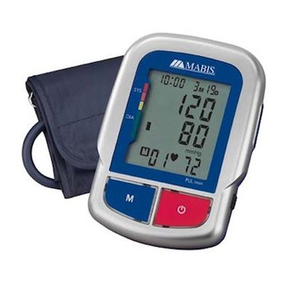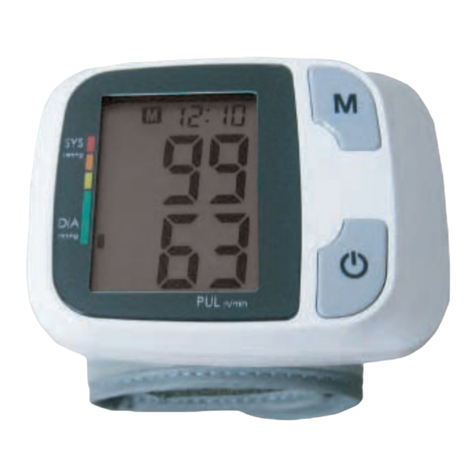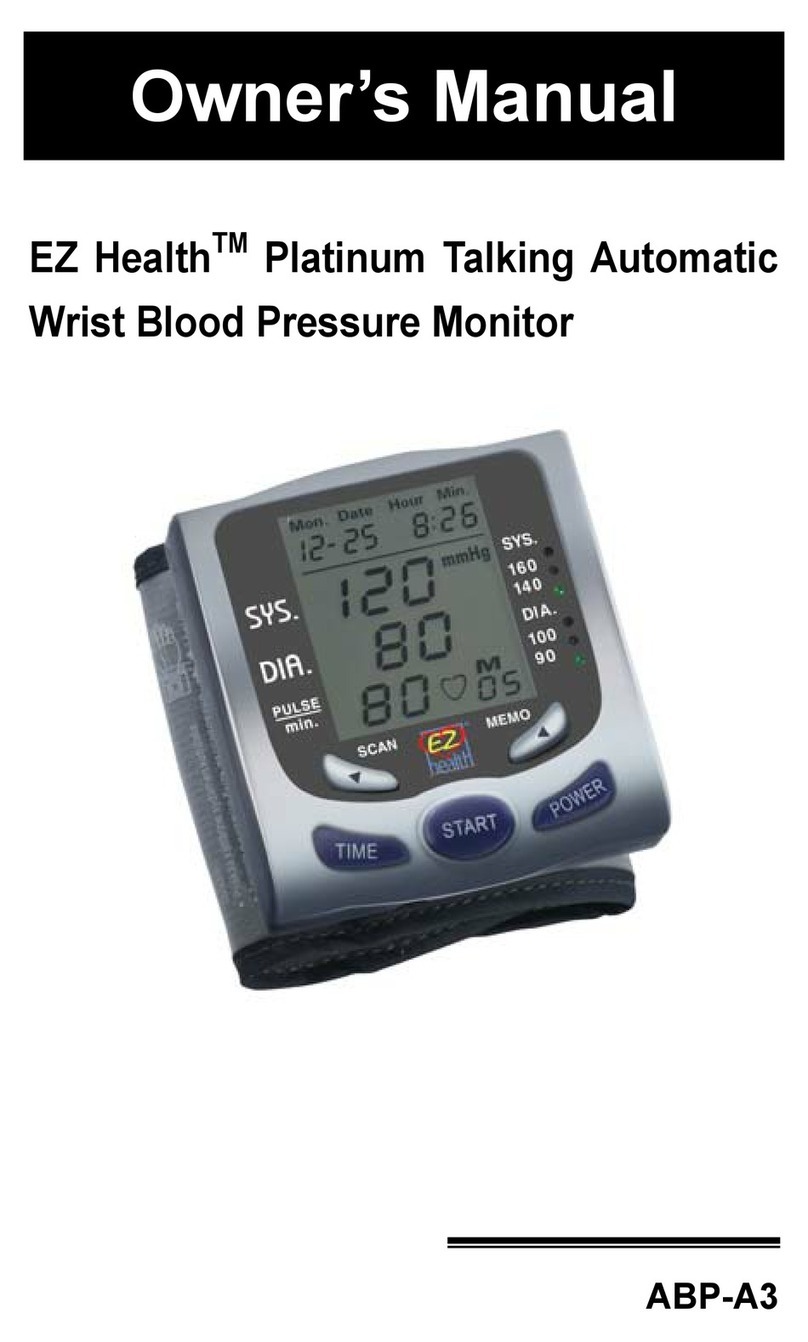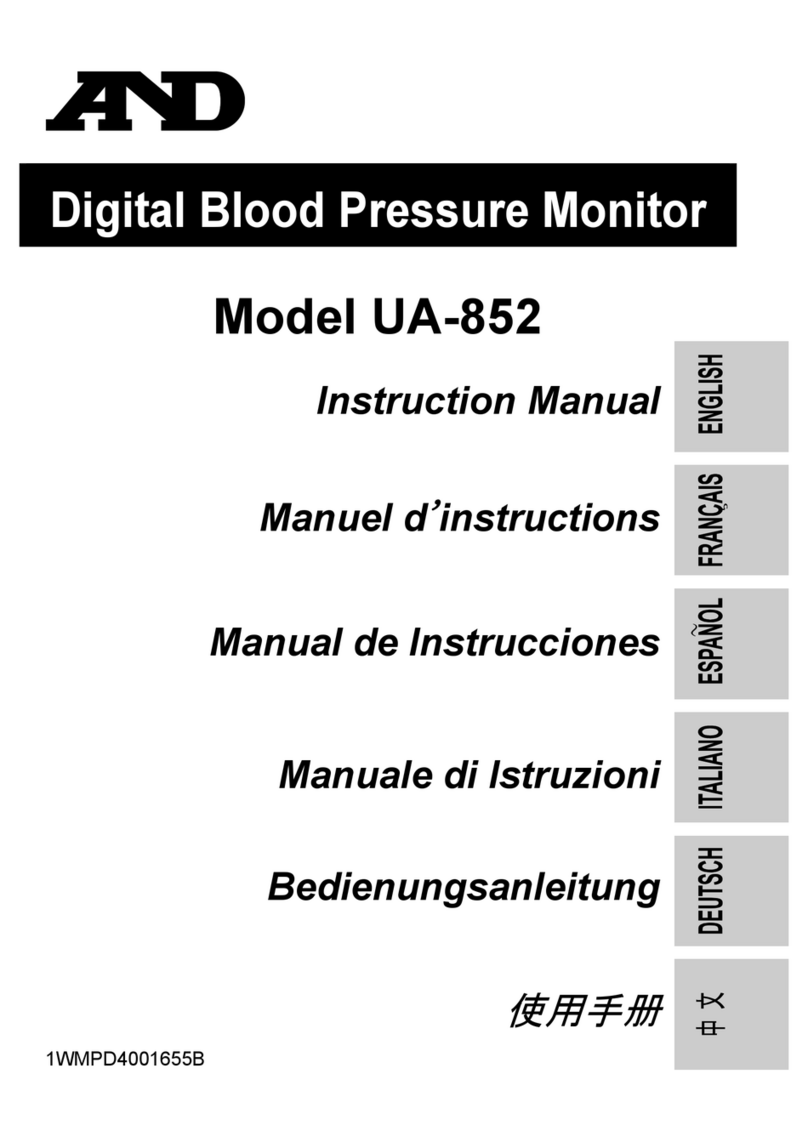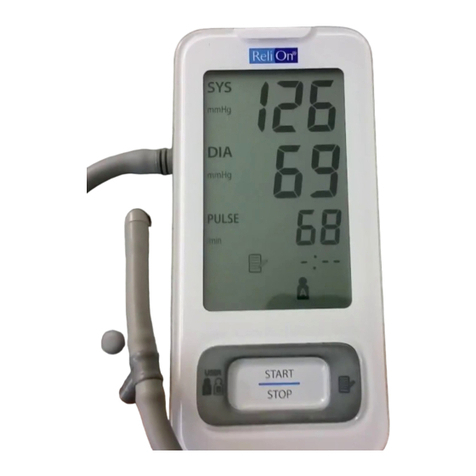Smart Meter iBloodPressure SMBP802-GS-001 User manual

Arm Type
iBloodPressure®
Cellular Blood Pressure Monitor
Model SMBP802-GS-001
User Manual
To use the monitor correctly and safely, please read the manual thoroughly.
Please keep this manual in order to reference in future.
Manufactured for:
Smart Meter, LLC
201 E. Kennedy Blvd., Suite 880
Tampa, FL 33602
B-O-UM-U-0521

CATALOGUE CATALOGUE
1
Table of Contents
INTRODUCTION...................................................................................................................2
General Description
Indications for Use
Contraindications
Measurement Principle
Safety Information
LCD Display Signal
Components of the Device
List
BEFORE YOU START...........................................................................................................9
The Choice of Power Supply
Installing and Replacing the Batteries
D
MEASUREMENT.................................................................................................................11
Tie the Cuff
Taking a Measurement
INFORMATION FOR USER................................................................................................14
Tips for measurement
Maintenances
ABOUT BLOOD PRESSURE..............................................................................................16
What are systolic pressure and diastolic pressure?
What is the standard blood pressure classification?
Irregular heartbeat detector
Why does my blood pressure fluctuate throughout the day?
Why do I get a different blood pressure at home compared to the hospital?
Is the result the same if measuring on the right arm?
TROUBLESHOOTING ........................................................................................................18
SPECIFICATIONS...............................................................................................................19
COMPLIED STANDARDS...................................................................................................20
EMC GUIDANCE.................................................................................................................21
FCC STATEMENT................................................................................................................24
CONTACT INFORMATION..................................................................................................25

2 3
INTRODUCTION INTRODUCTION
This product uses the Oscillometric Measuring Method to detect blood pressure.
Before every measurement, the unit establishes a “zero point” equivalent to the
atmospheric pressure. Then it starts inflating the cuff. Meanwhile, the unit detects
pressure oscillation generated by beat-to-beat pulsatile, which is used to
determine the systolic pressure and diastolic pressure as well as pulse rate.
Measurement Principle
1. The device should not be used by any person who is or may be pregnant.
2. The device is not suitable for use on patients with implanted electrical devices,
such as cardiac pacemakers and defibrillators.
The signs below might be in the user manual, labeling or other components.
They are the requirement of standard and using.
Safety Information
Symbol for “RECYCLE”
Symbol for “THE OPERATION
GUIDE MUST BE READ”
Symbol for “MANUFACTURER”
Symbol for “SERIAL NUMBER”
Symbol for “TYPE BF APPLIED
PARTS”
Symbol for “DIRECT CURRENT”
Symbol for “ENVIRONMENT
PROTECTION - Electrical waste
products should not be disposed of
with household waste. Please recycle
where facilities exist. Check with your
local authority or retailer for recycling
advice”
Caution: These notes must
be observed to prevent any
damage to the device.
SN
Symbol for “MANUFACTURE
DATE”
General Description
The iBloodPressure®monitor features blood pressure measurement,
pulse rate measurement, and cellular result transmission to cloud
storage. The design provides you with two years of reliable service.
Readings taken are equivalent to those obtained by a trained observer
using the cuff and stethoscope auscultation method. This manual
contains important safety and care information and provides step by
step instructions for using the product. Read the manual thoroughly
before using the product.
Features:
78*92 mm Digital LCD display
Measuring during inflation technology
E-MTC wireless communication
Indications for Use
The iBloodPressure Blood Pressure Monitor is digital monitors intended for
use in measuring blood pressure and heartbeat rate with arm circumference
ranging from 22 cm to 42 cm (about 8.6 in - 16.5 in) or 22 cm to 45 cm
(about 8.6 in. – 17.7 in.).
It is intended for adult indoor use only.
Contraindications
Warranty
Smart Meter LLC warrants that this product will be free from defects in materials
and workmanship for two years from the date of purchase.
This warranty does not apply to the performance of an iBloodPressure®
Meter that has been altered, misused, tampered with or abused in any way. This
warranty applies only to the original purchaser of the iBloodPressure.
iBloodPressure is a trademark of Smart Meter LLC

4 5
* This device may be used only for the purpose described in this booklet. The manufacturer
and Smart Meter cannot be held liable for damage caused by an incorrect application.
INTENDED USERS AND USES CAUTIONS
* This device is intended for adult home use only.
* This device is intended for non-invasive measuring and monitoring of arterial blood
pressure. It is not intended for use on extremities other than the arm or for functions other
than obtaining a blood pressure measurement.
* The device is not suitable for use on neonatal patients, pregnant women, patients with
implanted electronic devices, patients with pre-eclampsia, premature ventricular beats,
atrial fibrillation, peripheral arterial disease, patients undergoing intravascular therapy,
patients with an arterio-venous shunt, or mastectomy patients. Please consult your doctor
before using the unit if you suffer from these or other illnesses.
* The device is not suitable for measuring the blood pressure of children. Ask your doctor
before using it on older children.
* This device is contraindicated for any female who may be suspected of or is pregnant.
Besides providing inaccurate readings, the effects of this device on the fetus are unknown.
* Do not confuse self-monitoring with self-diagnosis. This unit allows you to monitor your
blood pressure. Do not begin or end medical treatment without asking a physician for
treatment advice.
* If you are taking medication, consult your physician to determine the most appropriate time
to measure your blood pressure. Never change prescribed medication without consulting
your physician.
* Consult your doctor if you have any questions about your blood pressure.
* When the device is used to measure patients who have common arrhythmias such as
atrial or ventricular premature beats or atrial fibrillation, the best result may occur with
deviation. Please consult your physician about the result.
* Do not apply the cuff on an arm that has other medical devices, an intravenous drip, or a
blood transfusion attached.
* Warning: Do not apply the cuff over a wound as it can cause further injury.
* This device was clinically investigated according to the requirements of ISO 81060-2:2013.
USE ENVIRONMENT CAUTIONS
* Please use the device in the environment described in this manual. Otherwise, the
performance and lifetime of the device will be reduced.
* The device is intended for indoor home use.
* The device is not intended for use during patient transport.
* The device is not intended for public use.
* The device cannot be used with HF surgical equipment at the same time.
* The device is not AP/APG equipment and not suitable for use in the presence of a
flammable anesthetic mixture with air of oxygen or nitrous oxide.
* This unit is not suitable for continuous monitoring during medical emergencies or
operations.
INTRODUCTION INTRODUCTION
* To avoid measurement errors, avoid electromagnetic field radiated interference signals or
electrical fast transient/burst signals.
* Wireless communications equipment such as wireless home network devices, mobile
phones, cordless telephones and their base stations, and walkie-talkies may affect this
equipment and should be kept at least 13 feet away from the device during use. The
distance of 13 feet is calculated by the manufacturer from the 80 MHz to 5.8 GHz column
of Table 4 and Table 9 of IEC 60601-1-2:2014, as appropriate.
* At least 30 minutes is required for the device to warm from the minimum storage
temperature until it is ready for use. At least 30 minutes is required for the device to cool
from the maximum storage temperature until it is ready for use.
* The blood pressure monitor and the cuff are suitable for use within the home
environment. If you are allergic to polyester, nylon, or plastic, please don't use this
device.
* During use, the patient will be in contact with the cuff. The materials of the cuff have been
tested and found to comply with requirements of ISO 10993-5:2009 and ISO
10993-10:2010. The cuff should not cause irritation.
USE CAUTIONS
* Too frequent and consecutive measurements could cause disturbances in blood
circulation and injuries.
* When using this device, please pay attention to the following situations which may
interrupt blood flow and influence blood circulation and cause injury: connection tube
kinking, too frequent and multiple consecutive measurements, the application of the cuff
and pressurization on any arm with intravascular access therapy, where an arterio-
venous (A-V) shunt is present, and inflating the cuff on the side of a mastectomy.
* Don't compress, restrict, or kink the connection tube during use, otherwise, the cuff
pressure may continuously increase which can prevent blood flow and result in injury.
* Please check that operation of the device does not result in prolonged impairment of
blood circulation.
* If you experience discomfort during measurement, such as pain in the arm, press any
button to release the air immediately from the cuff. Loosen the cuff and remove it from
your arm.
* If the cuff pressure reaches 40 kPa (300 mmHg), the unit will automatically deflate.
Should the cuff not deflate when the pressure reaches 40 kPa (300 mmHg), detach the
cuff from the arm immediately and press any button to stop inflation. Prolonged high
pressure (cuff pressure >300 mmHg or constant pressure>15 mmHg for more than 3
minutes) applied to the arm may lead to an ecchymosis.
* The operator should not touch the power supply and the patient simultaneously.
CAUTION CAUTION

7
6
INTRODUCTION
INTRODUCTION
LCD Display Signal
SYMBOL DESCRIPTION
Systolic blood pressure High pressure result
Diastolic blood pressure Low pressure result
EXPLANATION
Current Time Time(year:month:day:hour:minute)
mmHg Measurement Unit of the blood pressure
Battery Indicator Indicate the current battery level
Irregular heartbeatIrregular heartbeat
Heartbeat Heartbeat detection during measurement
Shaking reminder Shacking will result in inaccurate
MAINTENANCE AND STORAGE CAUTIONS
* This device contains sensitive components and must be treated with caution. Observe the
storage and operating conditions described in this booklet.
* When not in use, store the device in a dry room and protect it against extreme moisture,
heat, lint, dust, and direct sunlight. Never place any heavy objects on the storage case.
* Keep the unit out of reach of infants, young children, or pets to avoid inhalation or
swallowing of small parts and possible strangulation from the hose or cable.
* Cleaning: Dusty environments may affect the performance of the unit. Please use a soft
cloth to clean the whole unit before and after use. Don’t use abrasive or volatile cleaners.
* Do not wash the cuff in a washing machine or dishwasher.
* The service life of the cuff may vary by the frequency of washing, skin condition, and
storage state. The typical service life is 10,000 uses.
* Before use, make sure the device functions safely and is in proper working condition.
Check the device and do not use the device if it is damaged in any way. The continuous
use of a damaged unit may cause injury, improper results, or danger.
* It is recommended that the performance of the device be checked every 2 years.
* Please use only accessories and detachable parts specified/authorized by Smart Meter.
* Please dispose of the device and accessories according to local guidelines.
* Do not open or attempt to repair or service the device at any time.
* If you have any questions or problems with this device, please contact Smart Meter
Customer Service.
Signal indication Indicates the signal situation in the communication
process.
CAUTION
Blink to indicate that the data is being sent, the
send success will disappear.
Data transmission indication

9
8
List
1. Cellular Blood Pressure
Monitor (SMBP802-GS-001)
3. User manual 4. 4*AA batteries
2. Cuff (22~42 cm or 22~45 cm)
(Type BF applied part)
The Choice of Power Supply
1.Battery powered mode:
6VDC 4*AA batteries
2.AC adapter powered mode:
6V 1A (not included)
(Please use the AC adapter which
authorized by the manufacturer!)
Installing and Replacing the Batteries
BEFORE YOU START
INTRODUCTION
In order to get the best effect and protect your monitor, please use the right
batteries and special power adapter which complies with local safety standard.
Component list of
pressure measuring system:
1 Cuff
2 Air pipe
3 PCBA
4 Pump
5 Valve
Replace the batteries whenever the below happens
The shows
The display dims
The display does not light up
Do not use new and used batteries together.
Do not use different types of batteries together.
Do not dispose the batteries in fire. Batteries may explode or leak.
Remove batteries if the device is not likely to be used for some time.
Worn batteries are harmful to the environment. Do not dispose with daily garbage.
Remove the old batteries from the device following your local recycling guidelines.
AC adapter
BATTERY COMPARTMENT
BATTERY DOOR
CUFF TUBE
CUFF
START/STOP BUTTON
DC POWER SOCKET
CUFF TUBE CONNECTOR
CAUTION
CAUTION
Components of the Device
If this is your first time using the device:
1.Slide open the battery door on the back of the device.
2.Install the batteries provided with the device. Follow
the diagram inside the battery compartment for correct
polarity—the springs should align with the negative
sign on the batteries.
3.Slide the battery door closed.

11
10
MEASUREMENT
Tie the Cuff
2~3cm
BEFORE YOU START
Tip:
Replace the battery or connect AC adapter, the symbol and will be
shown on the LCD, indicating pair-up is proceeding alternatively.
You can press “ START/STOP ” button at any time to stop pair-up.
If SUCCEED, symbol will be shown on the LCD.
1.
2.
3.
4.
5.
6.
7.
8.
9.
10.
11.
If FAIL, the monitor will turn off automatically.
Plug the connector on cuff tube into the
device.
Expose your upper arm by removing or
adjusting clothing and jewelry. Make
sure blood flow is not constricted by a
rolled up sleeve.
Open the cuff and loosen fully.
Orient the cuff so that the tube exits
towards the hand.
Place your arm through the cuff loop,
with your palm facing up.
Position the cuff's edge about an inch
(2–3 cm) above the elbow.
Align the Фmarker (located to the right
of the tube exit) with the center of your
arm.
Tighten the cuff evenly around your arm
by pulling on the end—make sure the Ф
marker stays aligned with the center of
your arm.
Wrap the end of the cuff over your arm
to secure it in place. Don't make it too
tight—allow a finger to fit between the
cuff and your arm.
If possible, relax and rest for at least 5
minutes before taking a measurement.
Lay your arm on a table with your palm
facing up. The cuff should be at the
same height as your heart. Sit up
straight and rest your feet flat on the
ground. Make sure the tube is not kinked
or pinched.

13
12
1.When the monitor is off, press the
“ START/STOP ” button to turn on the
monitor. The cuff will automatically
inflate, complete the measurement,
and transmit the results.
MEASUREMENTMEASUREMENT
Display resets to zero.
LCD display
Inflating and measuring. Display the results.
2.This device will proceed to data
transmission after measurement.
The symbol blinks on the
LCD indicates data is
transmitting.
Taking a Measurement
Transmitting results.
Tip:
You can press “ START/STOP ” button at any time to stop measuring during
the process.
3.If the data is successfully
transmitted, the symbol
will disappear and the LCD
will display and then the
device will turn off automatically.
If the data transmission fails,
Error message will be shown
(take E6 for example) on the
display for several seconds
then the device will turn off
automatically.
Note: the result will be
transmitted next time a
cellular connection is made.

1514
Tips for Measurement
Measurements may be inaccurate if taken in the following
circumstances.
INFORMATION FOR USERINFORMATION FOR USER
Maintenance
To get the best performance, please follow the steps below.
Store in a dry place and avoid the sunshine
Avoid intense shaking
and dropping
Use a damp cloth to remove dirt
Avoid contact with water,
clean exterior with a dry cloth
Avoid dusty places and
unstable temperatures
Avoid washing the cuff
Within 1 hour
after dinner or drinking
Within 20 minutes
after taking a bath
In a very cold environment
Immediately after
tea, coffee, smoking
When talking or moving
your hands
When you need to urinate

17
16
What are systolic pressure and diastolic pressure?
press
artery vein
blood discharging
Systolic
relax
blood entering
Diastolic
When ventricles contract and pump blood out
of the heart, the blood pressure reaches its
maximum value in the cycle, which is called
systolic pressure. When the ventricles relax,
the blood pressure reaches its minimum value
in the cycle, which is called diastolic pressure.
Irregular Heartbeat Detector
ABOUT BLOOD PRESSURE
An irregular heartbeat is detected when a heartbeat rhythm varies while the device is
measuring systolic pressure and diastolic pressure. During each measurement, the
blood pressure monitor will keep a record of all the pulse intervals and calculate their
average value. If there are two or more pulse intervals with an average difference
between each interval of more than ±25%, or if there are four or more pulse intervals,
with an average difference between each interval of ±15%, then the irregular
heartbeat symbol will appear on the display with the measurement result.
ABOUT BLOOD PRESSURE
Why does my blood
pressure fluctuate
throughout the day?
Is the result the same if measuring on the
right arm?
Why do I get a different blood pressure at
home compared to the hospital?
1. Individual blood pressure varies throughout the day. It is also affected by the
way you tie your cuff and your measurement position. It is recommended that
you take your measurement under the same conditions.
2. If you take medicine, your pressure may vary more.
3. Wait at least 3 minutes between measurements.
The blood pressure is different throughout the day due to weather,
emotion, exercise, etc. Also, there is the “white coat” effect, which means
blood pressure usually increases in clinical settings.
It is okay to measure on either arm, however; there may be different results
for some people. We suggest you measure the same arm every time.
If the cuff is tied properly.
If the cuff is too tight or too loose.
If the cuff is tied on the upper arm.
If you feel anxious.
Take 2-3 deep breaths before you begin measuring.
Relax for 4-5 minutes until you are calm.
What is the standard blood pressure classification?
The chart on the right is the
standard blood pressure classifi-
cation published by American
Heart Association (AHA).
Please consult a physician if your result falls outside the range. Please note
that only a physician can tell whether your blood pressure value has
reached a dangerous point.
Blood Pressure Category
Normal
Prehypertension
High Blood Pressure
(Hypertension) Stage 1
High Blood Pressure
(Hypertension) Stage 2
Hypertensive Crisis
(Consult your doctor immediately)
Systolic
mmHg (upper#)
Diastolic
mmHg (lower#)
less than 120
120-129
130-139
140 or higher
Higher than 180
and
or
or
and/or
less than 80
80-89
90 or higher
Higher than 120
This chart reflects blood pressure categories defined by American Heart Association.
and less than 80
Pay special attention to the following when you
measure your blood pressure at home:
The appearance of the IHB icon indicates that a pulse irregularity consistent with an
irregular heartbeat was detected during measurement. Typically this is NOT a cause
for concern. However, if the symbol appears often, we recommend you seek medical
advice. Please note that the device does not replace a cardiac examination, but serves
to detect pulse irregularities at an early stage.
CAUTION
CAUTION

19
18
This section includes a list of error messages and frequently asked
questions for issues you may encounter with your blood pressure
monitor.
TROUBLESHOOTING
PROBLEM SYMPTOM CHECK THIS REMEDY
No power
or Low
batteries
Error
message
Display
will not light up
Batteries are exhausted. Replace with new batteries.
Insert the batteries
correctly.
Batteries are inserted
incorrectly.
E 1 shows
E 2 shows
E 3 shows
Movement can affect the
measurement.Relax for a
moment and then
measure again.
E 4 shows
EExx,shows on
the display.
A calibration error
occurred.
Retake the measurement.
If the problem persists,
contact customer service
for further assistance.
Refer to the warranty for
contact information and
return instructions.
E 5 shows
AC adapter is inserted
incorrectly.
Insert the AC adapter
tightly.
or
shows
The monitor detected
motion,talking or the
pluse is too weak
while measuring.
Warning
message Out shows Out of measurement
range.
Relax for a moment.
Refasten the cuff and then
measure again. If the
problem persists, contact
your physician.
Digital LCD V.A.78 mm*92 mm
Approx.393g (Excluding the batteries)
Approx.154.3 mm*121.5 mm*68.1 mm
6VDC 4×AA batteries
4×AA batteries, user manual
6V 1A (not included)
Battery powered mode:
AC adapter powered mode:
(Please only use the recommended AC
adapter model).
About 22 cm~42 cm or 22 cm~45 cm
Type BF applied part
WARNING: No modification of this equipment is allowed.
Power supply
Display mode
Measurement mode Oscillographic testing mode
Measurement range
Measurement perimeter
of the upper arm
Weight
External dimensions
Attachment
Mode of operation Continuous operation
Degree of protection
Protection against
water ingress
Accuracy
Normal working condition
Storage & transportation
condition
Software Version
Pressure:
within ±3 mmHg (0.4 kPa)
Pulse value: ±5%
Rated cuff pressure:
0 mmHg ~ 299 mmHg (0 kPa ~ 39.9 kPa)
Measurement pressure:
SYS: 60 mmHg ~ 230 mmHg (8.0 kPa ~ 30.7 kPa)
DIA: 40 mmHg ~ 130 mmHg (5.3 kPa ~ 17.3 kPa)
Pulse value: (40-199)beat/minute
IP21: It means that the device could protect against
solid foreign objects of 12.5 mm and greater, and
protect against vertically falling water drops.
Device Classification Battery Powered Mode:
Internally Powered ME Equipment
AC Adapter Powered Mode: Class II ME Equipment
A temperature range of: +5°C to +40°C
A relative humidity range of 15% to 90%,
non-condensing, but not requiring a water vapour
partial pressure greater than 50 hPa
An atmospheric pressure range of:
700 hPa to 1060 hPa
Temperature: -20°C to +60°C
A relative humidity range of ≤ 93%, non-condensing,
at a water vapour pressure up to 50 hPa
SPECIFICATIONS
Refasten the cuff and then
measure again.
The measurement
process does not detect
the pulse signal.
Loosen the clothing on the
arm and then measure
again.
Not able to calculate,
measurement failed.
Relax for a moment and
then measure again.
Failed to communicate
with the server.
Contact customer service.
No access to network.
E 6 shows Contact customer service.
A01
The cuff is not secure
or abnormal inflation.

21
20
Complied Standards List
EN ISO 14971:2012 / ISO 14971:2007 Medical devices - Application of
risk management to medical devices
EN 60601-1:2006+A1:2013/ IEC 60601-1:2005+A1:2012 Medical
electrical equipment - Part 1: General requirements for basic safety
and essential performance
EN 60601-1-11:2015/ IEC 60601-1-11:2015 Medical electrical
equipment - Part 1-11: General requirements for basic safety and
essential performance - Collateral standard: Requirements for medical
electrical equipment and medical electrical systems used in the home
healthcare environment
EN 60601-1-2:2015/ IEC 60601-1-2:2014 Medical electrical equipment
- Part 1-2: General requirements for basic safety and essential
performance - Collateral standard: Electromagnetic disturbances -
Requirements and tests
EN ISO 81060-1:2012 Non-invasive sphygmomanometers - Part 1:
Requirements and test methods for non-automated measurement type
EN 1060-3:1997+A2:2009 Non-invasive sphygmomanometers - Part 3:
Supplementary requirements for electro-mechanical blood pressure
measuring systems
EN 60601-1-6:2010+A1:2015/IEC 60601-1-6:2010+A1:2013 Medical
electrical equipment - Part 1-6: General requirements for basic safety
and essential performance - Collateral standard: Usability
IEC 62366-1:2015 Medical devices - Part 1: Application of usability
engineering to medical devices
EN 62304:2006/AC: 2008 / IEC 62304: 2006+A1:2015 Medical
device software - Software life-cycle processes
Risk management
Labeling
User manual
General Requirements
for Safety
Electromagnetic
compatibility
Performance
requirements
Clinical investigation
Usability
Software life-cycle
processes
Bio-compatibility
ISO 10993-1:2009 Biological evaluation of medical devices- Part 1:
Evaluation and testing within a risk management process
ISO 10993-5:2009 Biological evaluation of medical devices - Part 5:
Tests for in vitro cytotoxicity
ISO 10993-10:2010 Biological evaluation of medical devices - Part
10: Tests for irritation and skin sensitization
EN ISO 15223-1:2016 / ISO 15223-1:2016 Medical devices. Symbols
to be used with medical device labels, labelling and information to be
supplied. Part 1 : General requirements
IEC 80601-2-30:2018 Medical electrical equipment- Part 2-30:
Particular requirements for the basic safety and essential
performance of automated non-invasive sphygmomanometers
EN 1060-4:2004 Non-invasive sphygmomanometers - Part 4: Test
procedures to determine the overall system accuracy of automated
non-invasive sphygmomanometers
ISO 81060-2:2018 Non-invasive sphygmomanometers - Part 2:
Clinical validation of automated measurement type
EMC GUIDANCECOMPLIED STANDARDS
EMC Guidance
The ME EQUIPMENT or ME SYSTEM is suitable for home healthcare environments
Warning: Do not use near active HF surgical equipment and the RF shielded room of an ME system for
magnetic resonance imaging, where the intensity of EM disturbances is high.
Warning: Use of this equipment adjacent to or stacked with other equipment should be avoided because it
could result in improper operation. If such use is necessary, this equipment and the other equipment should be
observed to verify that they are operating normally.
Warning: Use of accessories, transducers and cables other than those specified or provided by the
manufacturer of this equipment could result in increased electromagnetic emissions or decreased
electromagnetic immunity of this equipment and result in improper operation.
Warning: Portable RF communications equipment (including peripherals such as antenna cables and external
antennas) should be used no closer than 30 cm (12 inches) to any part of the equipment SMBP802-GS-001,
including cables. Otherwise, degradation of the performance of this equipment could result.
Technical description:
1,All necessary instructions for maintaining BASICSAFETY and ESSENTIALPERFORMANCE with regard
to electromagnetic disturbances for the excepted service life.
2,Guidance and manufacturer’s declaration -electromagnetic emissions and immunity
Table 1
Guidance and manufacturer’s declaration - electromagnetic emissions
RF emissions
CISPR 11
Group 1
Class [ B ]
Class A
Comply
Compliance
Harmonic emissions
IEC 61000-3-2
Voltage fluctuations/
flicker emissions
IEC 61000-3-3
RF emissions
CISPR 11
Emissions test
EN 1041:2008 +A1:2013 Information supplied by the manufacturer of
medical devices

2322
Guidance and manufacturer’s declaration – electromagnetic Immunity
Table 2
Immunity Test
±8 kV contact
±2 kV,±4kV, ±8 kV, ±15 kV air
±1 kV ±2 kV,100 kHz repetition frequency
±1 kV (Line to ±0.5 kV line)
±0.5 kV ±1 kV ±2 kV (Line to ground)
±2 kV Signal line (LAN line)
0%, 70%,0% of UT
30 A/m
50 Hz/60 Hz
NOTE U
T
is the a.c. mains voltage prior to application of the test level.
Compliance level
Electrostatic
discharge (ESD)
IEC 61000-4-2
30 A/m
50 Hz/60 Hz
Power frequency
magnetic field
IEC 61000-4-8
Voltage dips, short
interruptions and
voltage variations
on power supply
input lines
IEC 61000-4-11
Electrical fast
transient/burst
IEC 61000-4-4
Surge
IEC61000-4-5
IEC 60601-1-2
Test level
For AC power port:
0 % for 0,5 cycle,0°for 1 cycle
70 % for 25 cycles;
Single phase: 0% for 250 cycle
±8 kV contact
±2 kV, ±4kV, ±8 kV,
±15 kV air
For AC power port:
Power supply lines: ±2 kV
For AC power port:
Line to lines: ±1 kV
Conduced RF
IEC61000-4-6
0,15 MHz – 80 MHz 3V
ISM and amateur radio bands between
0,15 MHz and 80 MHz 6V
For AC power port:
3 Vrms
6 Vrms(in ISM and amateur radio
bands) 80% AM at 1 KHz
10 V/m
80 MHz – 2,7 GHz
80%AM at 1 kHz
10 V/m
80 MHz – 2,7 GHz
80 % AM at 1kHz
Radiated RF
IEC61000-4-3
EMC GUIDANCE
Table 3
Guidance and manufacturer’s declaration - electromagnetic Immunity
Test
Frequency
(MHz)
3850.3 27
Radiated RF
IEC61000-4-3
(Test
specifications
for
ENCLOSURE
PORT
IMMUNITY to
RF wireless
communica-
tions
equipment)
Band
(MHz)
Service Modulation Modulation
(W)
Distance (m)
IMMUNITY
TEST
LEVEL
(V/m)
380-390TETRA
400
Pulse
modulation b)
18 Hz
1.8
450430-470
GMRS 460,
FRS 460
FM c) ± 5 kHz
deviation 1 kHz
sine
2 0.3 28
710704-787
745
780
LTE Band
13,
17
Pulse
modulation b)
217 Hz
0.2 0.3 9
810
870
930
800-960
GSM
800/900,
TETRA 800,
iDEN 820,
CDMA 850,
LTE Band 5
Pulse
modulation b)
18 Hz
20.3 28
1720
1845
1970
1700-
1990
GSM 1800;
CDMA 1900;
GSM 1900;
DECT;
LTE Band 1,
3,
4,25; UMTS
Pulse
modulation b)
217 Hz
20.3 28
20.3 2824502400-
2570
Bluetooth,
WLAN,
802.11
b/g/n, RFID
2450, LTE
Band 7
Pulse
modulation
217 Hz
5240
5500
5785
5100-
5800
WLAN
802.11
a/n
Pulse
modulation
217 Hz
0.2 0.3 9
EMC GUIDANCE

24 25
FCC STATEMENT CONTACT INFORMATION
Authorized Components
1.Please use the iBloodPressure®
authorized adapter (not included).
Contact Information
BLJ06L060100P-U
100-240 V 50-60 Hz, 0.2 A max
6V 1000 mA
Adapter
Type:
Input:
Output:
Manufactured for:
Company:
Address: 201 East Kennedy Blvd. Suite 880
Tampa, FL 33602
www.smartmetercorporation.com
Toll Free Customer Support:
1-844-445-8267
Mon-Fri 9am-9pm ET
Smart Meter, LLC
Smart Meter, LLC
FCC Statement
This device complies with Part 15 of the FCC Rules. Operation is subject
to the two conditions: (1) this device may not cause harmful interference,
and (2) this device must accept any interference received, including
interference that may cause undesired operation.
Caution: The user is cautioned that changes or modifications not expressly
approved by the party responsible for compliance could void the user's
authority to operate the equipment.
NOTE: This equipment has been tested and found to comply with the limits
for a Class B digital device, pursuant to Part 15 of the FCC Rules. These
limits are designed to provide reasonable protection against harmful
interference in a residential installation. This equipment generates, uses
and can radiate radio frequency energy and, if not installed and used in
accordance with the instructions, may cause harmful interference to radio
communications. However, there is no guarantee that interference will not
occur in a particular installation.
If this equipment does cause harmful interference to radio or television
reception, which can be determined by turning the equipment off and on,
the user is encouraged to try to correct the interference by one or more of
the following measures:
-- Reorient or relocate the receiving antenna.
-- Increase the separation between the equipment and receiver.
-- Connect the equipment into an outlet on a circuit different from that to
which the receiver is connected.
-- Consult the dealer or an experienced radio/TV technician for help.
FCC Radiation Exposure Statement:
This equipment complies with FCC radiation exposure limits set forth for an
uncontrolled environment. This transmitter must not be co-located or
operating in conjunction with any other antenna or transmitter.
contains FCC ID:XMR2020BG95M2
2.BloodPressure Cuff SL
Table of contents
Other Smart Meter Blood Pressure Monitor manuals



